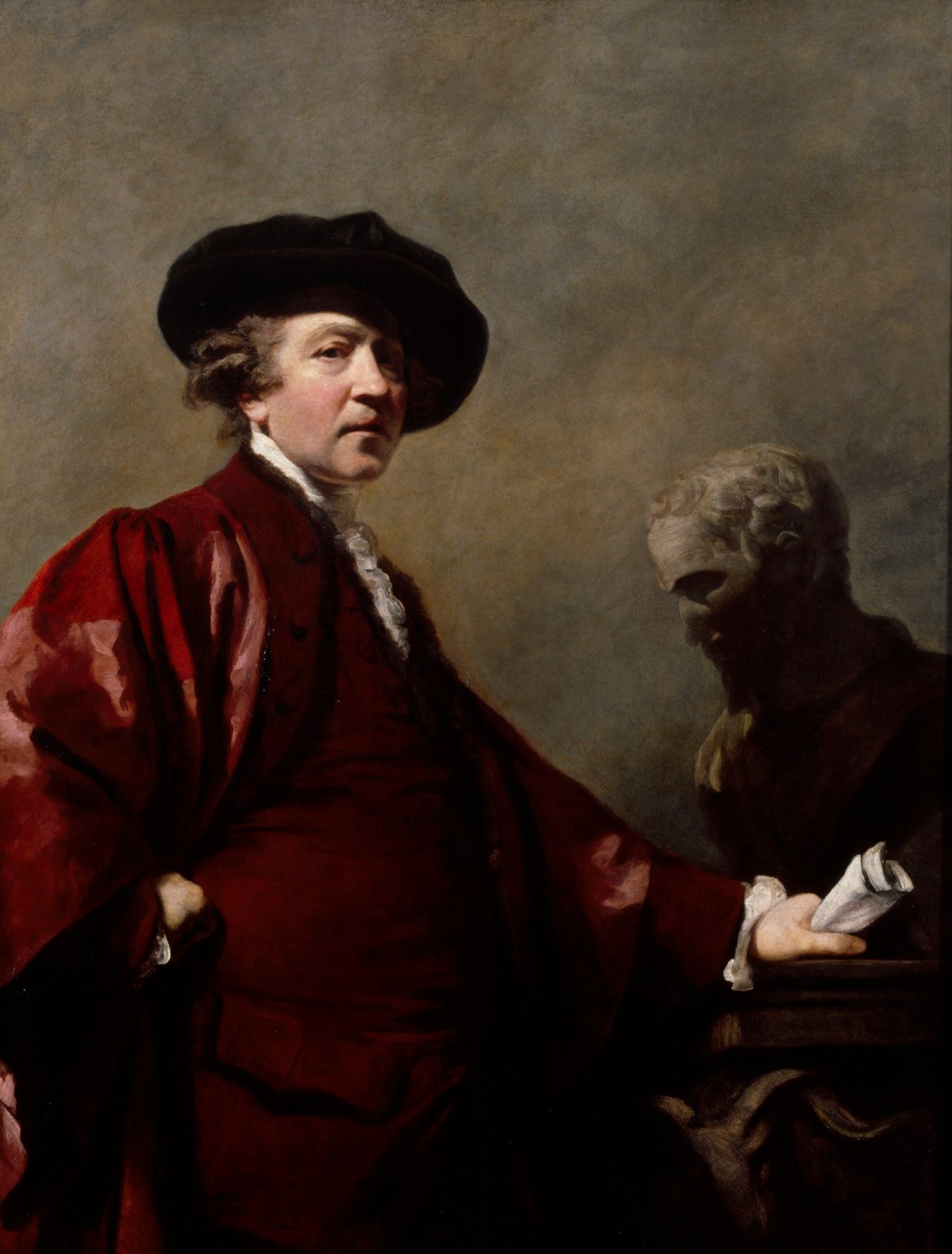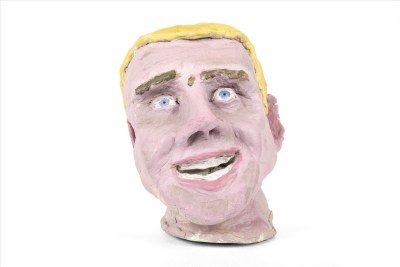
Sir Joshua Reynolds PRA, Self-portrait of Sir Joshua Reynolds, PRA, ca. 1780.
Oil on panel. 1270 mm x 1016 mm. © Photo: Royal Academy of Arts, London. Photographer: John Hammond.
This image is not available to download. To licence this image for commercial purposes, contact our Picture Library at picturelibrary@royalacademy.org.uk
Self-portrait of Sir Joshua Reynolds, PRA, ca. 1780
Sir Joshua Reynolds PRA (1723 - 1792)
RA Collection: Art
On free display in Collection Gallery
Sir Joshua Reynolds produced around thirty self-portrait paintings and drawings over his career (see Joshua Reynolds: The Creation of Celebrity, Tate Britain, 2005 exhibition catalogue, p. 73). This fascination with depicting himself was connected with his interest in Rembrandt whose portrait prints, in particular, were revered in Britain at this time. Reynolds emulated the Dutch master by using himself as a model in order to practice different facial expressions but, more significantly, he also favoured the genre of self-portraiture as a means of taking control of his own image and raising his own status as an artist and cultural figure. Reynolds' large, painted self-portraits - like this one - were produced at important moments in his life and have been characterised as 'part of a hard-headed public relations exercise' (Tate 2005, p.73). Reynolds freely admitted to his interest in fame and gaining a place in posterity with statements like the following: ''Distinction is what we all seek after, and the world does set a value on them [sic]. I go with the great stream of life' (cited in the Rebels and Martyrs catalogue, National Gallery, 2006, cat. no. 1).
In this stately portrayal, Reynolds celebrated his role as the first President of the Royal Academy, the 'premier artist of the British School and...the country's leading cultural figure' (Tate 2005, p.73). Reynolds was 57 by the time he painted this work, he had run the Academy for over a decade and was in the process of successfully overseeing its move into an elegant suite of purpose-built rooms at New Somerset House. The portrait is believed to have been painted specifically to hang in the Academy's new Assembly Room as a pendant to Reynolds' portrait of the architect of Somerset House and Treasurer of the Royal Academy, Sir William Chambers. Martin Postle has pointed out that both of these works are painted in oil on wood suggesting that they were intended as integral aspects of the decor of Somerset House. Indeed, a drawing by Chambers shows that they were to be placed on either side of the chimneypiece in the Assembly Room (see Nicholas Penny, 1986, pp. 284-5).For the Somerset House project, Reynolds also painted pendant portraits of the Academy's Royal patrons King George III and Queen Charlotte - to be hung in the same room - and the large allegorical painting Theory (03/202). However, there is no record of exactly when the portraits entered the RA Collection nor of any official commission from the Academy or the King or Queen for Reynolds to paint these works.
In his self-portrait, Reynolds deliberately paid homage to Rembrandt in both composition and technique and the painting has been specifically compared to Rembrandt’s Aristotle contemplating a Bust of Homer, 1653, (Metropolitan Museum of Art, New York), a painting later owned by Reynolds' friend Abraham Hume. In his Discourses on Art, Reynolds noted that Rembrandt unified his works by painting ‘little more than one spot of light in the midst of a large quantity of shadow’ (Reynolds, Discourse VIII , ed. R.R Wark, p.147). Here, light directed from the left highlights Reynolds' cheek, hand and the forehead of the bust while the remainder of the composition is thrown into shadowy contrast. Contemporaries noted the similarities in Reynolds’ and Rembrandt’s technique, particularly the 'production of effect by masterly, broad and rapid execution' that was 'the forte of both these painters' (William Hazlitt, The Complete Works of William Hazlitt , ed. P.P. Howe, 1933, XVII, p. 61).
While the painting is clearly indebted to Rembrandt, Reynolds also referenced his other artistic heroes. David Mannings noted that the pose Reynolds adopted probably derives from Van Dyck's engraved portrait of Adam De Coster (Penny, 1986). More significantly, Reynolds' left hand rests on a cast after a bust of Michelangelo by Daniele da Volterra (1564–1566, Casa Buonarroti, Florence). As Nicholas Penny has pointed out, this is likely to be the ‘bust in plaister of M Angelo’ which Reynolds owned and which was sold in the studio sale after the death of his niece (Christie’s, Lot 78, 19 May 1821 and Penny, 1986). Reynolds referred to Michelangelo as the 'Homer of Painting' and mentioned him frequently in his Discourses in which he praised the Renaissance artist's 'ideas...vast and sublime'. Reynolds finished his fifteenth and final Discourse by stating: ‘I should desire that the last words which I should pronounce in this Academy, and from this place, might be the name of MICHEL ANGELO’.
In comparing the pendant portraits of Chambers and Reynolds it is clear that the artist intended to assert himself as the Royal Academy's intellectual and artistic heavyweight. Chambers is presented as capable and urbane, seated at a desk with the facade of Somerset House behind him. However, Reynolds painted himself in the role of a thinker, dressed in the robes associated with the Doctorate of Civil Law which had been conferred on him by the University of Oxford in 1773. This device, along with the overt references to Michelangelo and Rembrandt, reinforces Reynolds' visual statement of academic authority. It is also likely to be a dig at Chambers who derailed Reynolds' attempts to introduce official academic robes for RAs in 1775 - including a special gown for the President (see letters between the two reproduced in Derek Hudson, Sir Joshua Reynolds: A Personal Study, London, 1958, pp. 125-6 ). Reynolds also painted a self-portrait for the Uffizi gallery in Florence in 1774 which employed similar devices: he wears his DCL robes and acknowledges his admiration for Michelangelo by holding a scroll inscribed ‘Disgeni del Divini Michelangelo Bon[arrotti]. On receiving the painting Giuseppe Pelli, Director of the Galleries, wrote to thank Reynolds, saying that the picture represented “all the beauties of Rembrandt’s manner carried to perfection’ (F.W. Hillies, Letters of Sir Joshua Reynolds , 1929, D).
Engraved:
Valentine Green, mezzotint, 1 December 1780
Joseph Collier, 10 July 1784 (oval head only)
A. Smith, 1 March 1794
Charles Turner, 1797 (in part)
H. Meyer, 8 May 1809 (vignette)
W. Bond, 1811
N. Schiavonetti, 21 May 1810 (part only)
William Bond, 20 January 1811
R.W. Sievier, 1 February 1820, lithograph (head only)
Samuel William Reynolds
Anon, vignette frontispiece to edition of the Discourses, published 17 June 1826 by Jones & Co.
Related works:
Contemporary replica in the collection of the Duke of Rutland - destroyed by fire at Belvoir Castle, 26 October 1816.
Half-length version sold Phillips, 6 June 1989, lot 35 (Mannings 2000, no. 20)
Half-length version, Private Collection (Ingamells, 2004, p. 395)
Copy, National Museum, Havana
Copy (half-length), by R.A. Clack, Royal Albert Memorial Museum, Exeter
B.R. Haydon, Copy of the head, pencil, sold Sotheby's, 3 October 1968, lot 192.
W.H. Craft, miniature copy, Ashmolean Museum, Oxford.
Henry Bone, R.A., Miniature copy, 1804, Royal Collection. (R.J. Walker, 1992, no. 783) copied by Sarah Barett Malden (Louvre).
Further reading:
Mark Hallett, Reynolds: Portraiture in Action, New Haven and London, 2014, pp. 344-45
Robert Wendorf, Sir Joshua Reynolds: The Painter in Society, Harvard, 2009, pp. 43-44
Martin Postle (ed.), Joshua Reynolds: The Creation of Celebrity, Tate Britain, London, 2005, cat. nos. 73 and 82
John Ingamells, The National Portrait Gallery, Mid Georgian Portraits 1760-1790, London: National Portrait Gallery, 2004, pp. 393-397, repd. p. 395
David Mannings, Sir Joshua Reynolds: a complete catalogue of his paintings; the subject pictures catalogued by Martin Postle, New Haven & London: Yale University Press, 2000, 2 vol. Text vol, no. 21, p. 51
Charles Robert Leslie, Life and Times of Sir Joshua Reynolds: with notices of some of his contemporaries. Commenced by C. R. L., continued and concluded by Tom Taylor. With portraits and illustrations, 2 vol. London, 1867, II, p. 290
James Northcote, The Life of Sir Joshua Reynolds , 2 vol, 1818, II, p. 89
Object details
1270 mm x 1016 mm
Associated works of art
2 results
Start exploring the RA Collection
- Explore art works, paint-smeared palettes, scribbled letters and more...
- Artists and architects have run the RA for 250 years.
Our Collection is a record of them.





